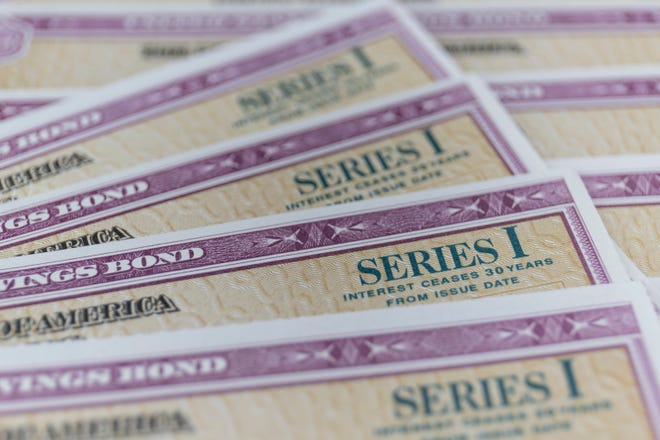
The good news is inflation has eased over the past year.
The bad news? So has the variable rate on those I bonds you bought back when inflation hit a 40-year high.
The I bonds you purchased in the summer of 2022, which paid a record 9.62% when inflation was soaring, are now paying about a third of that.
But with inflation down and interest rates up, thanks to aggressive Federal Reserve rate hikes over the past year and a half, you’ve got a lot of options to earn more than those I bonds offer, investment advisers say.
“You should sell them,” said Daniel Milan, investment adviser and managing partner at Cornerstone Financial Services in Southfield, Michigan.
Protect your assets: Best high-yield savings accounts of 2023
What’s the math on your I bonds?

The latest I bonds from Nov. 1 to April 30, 2024, are yielding 5.27%, according to the U.S. Department of Treasury, down from the record yield in summer 2022. That may not sound so bad since savings, money market funds, short-term Treasuries and certificates of deposit (CDs) are all hovering near the 5% range.
However, that 5.27% is only for new I bond purchases. It isn’t what you’re earning on I bonds you purchased in summer 2022 to receive the record 9.62%.
Overall, I bond rates are determined by both a fixed rate set by the Treasury for the 30-year life of the bond and a variable rate that moves with inflation. I bonds you bought in summer 2022 had a 0% fixed rate and a 9.62% variable rate. The variable rate resets every 6 months and has consistently fallen with inflation. It’s currently 3.97%, which is what you’re earning on those I bonds since the fixed rate is zero. (The variable rate is calculated by multiplying the semi-annual inflation rate, which is 1.97%, by two since it’s semi-annual and adding that to the product of the semi-annual inflation rate and the fixed rate.)
Higher fixed rate:New I Bonds hit 5.27% as fixed rate sees startling boost: What buyers should know
What should I invest in?
There are numerous, almost equally safe options that can earn you a better return than your 2022 I bonds, experts say.
- If you like I bonds, you can sell the old ones you own with a 0% fixed rate and buy new ones that have a 1.30% fixed rate and 3.97% variable rate for an overall rate of 5.27%. “The benefit of buying them now is that 1.3% is the highest fixed rate since 2007 so it’s an above-average fixed rate,” said Ken Tumin, senior analyst at online loan platform LendingTree and founder of Deposit Accounts, which tracks rates on various types of accounts. Just know that if inflation continues to fall, your variable rate and therefore, your overall rate, will follow.
- Invest in short-term CDs, online savings accounts, money market funds or Treasuries, which may offer similar or higher interest rates. Remember, though, if the Fed starts cutting rates next year as many expect, these yields will also fall. To counter that, Milan suggests Treasuries. “It may be worthwhile if you want a risk-free government bond, (to) get a 10-year because if rates go down, you’ll get a tailwind” on the rise in the price of the bond, he said. Why? Bond prices rise when their yields fall and vice versa. So, if the yield slips, you may be able to sell your bond for a 3% to 4% gain in price, he said.
Note: Interest on I bonds and Treasuries are only taxed federally. Interest from money market funds, CDs and savings accounts may also be subject to state and local taxes.
How do I sell I bonds?
You must have held your I bonds for at least a year.
To cash electronic bonds:
- Go to your TreasuryDirect account.
- Go to ManageDirect.
- Use the link for cashing securities.
If you have paper I bonds, you can check with your bank or do it directly with Treasury:
- Complete FS Form 1522.
- Get your signature certified, if necessary. (If the value you’re cashing is more than $1,000, you must have your signature certified.)
- Send the form and the bonds to Treasury at the address on FS Form 1522.
Notes:
- If you cash the bond in less than 5 years, you lose the last 3 months of interest. If you’ve held them for at least 5 years, there’s only federal tax on interest but no penalty. “That can make your I bonds a nice emergency fund at that point,” Tumin said.
- You don’t receive the month’s interest until the month is complete. So the best time to sell is after three straight months of low interest and then just after the 1st of the fourth month. That way, you hold onto the higher interest and shed the lower rate.
- If you buy I bonds, it’s best to do so at the end of the month since you only must own them by the last business day to receive the full month’s interest.
- I bond purchases are capped at $10,000 per person each calendar year. So if you bought $5,000 earlier in the year, sell them and want to buy more before the year ends, you can only buy $5,000 worth.
- You’ll receive a 1099-INT for your taxes. Interest from I bonds is federally, but not state and locally, taxed unless the money is used to pay for higher education.
Medora Lee is a money, markets, and personal finance reporter at USA TODAY. You can reach her at [email protected] and subscribe to our free Daily Money newsletter for personal finance tips and business news every Monday through Friday.






